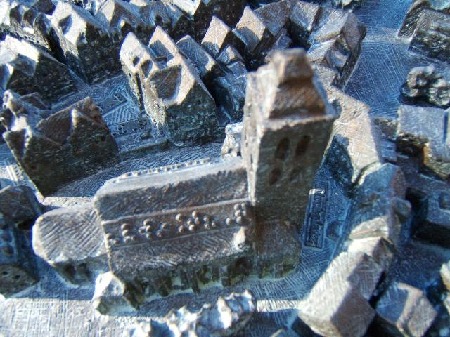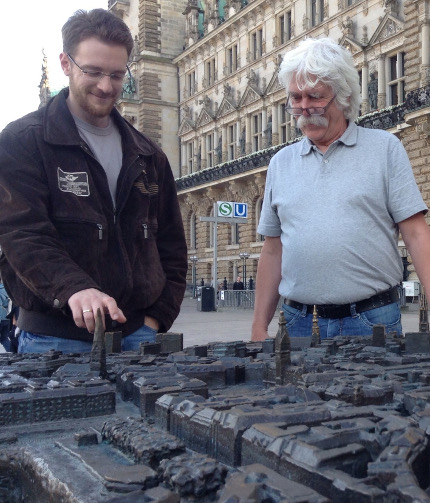The town you can touch
Take a walk through the streets on your fingertips
Sculptor Egbert Broerken developed the first bronze city models to feel, see and understand over 30 years ago. Together with his son Felix, the two artists have created more than 250 city models, which now characterize many inner cities and make a valuable contribution to inclusion.
Thanks to this globally unique wealth of experience in the development of bronze city models, we are the ideal partner and can guarantee a smooth and punctual process, from the planning of the model and the right choice of location to professional production and safe installation.

We attach particular importance to the design of our models. Each model is lovingly crafted by hand, allowing us to create haptically and visually appealing and exciting models, from the detailed depiction of the house facades to the artistic surface design, in contrast to the often artificial, smooth and poorly detailed representations created by machine 3D printing.
In many German cities - but also in Switzerland, Austria, France and the Netherlands - they have become a magnet for residents and visitors alike. And when the blind citizens feel their city, in which they have lived for a long time but which they have never been able to understand, it is always a moving moment. Walking through the streets with their fingertips. Feeling the layout of the squares and alleyways. Recognizing the differences in size between houses and churches. Experiencing the architecture and history of the city. When blind citizens feel their city for the first time, whose walls they can touch but whose dimensions they have never been able to grasp, it is a completely new experience for them. Bidhauer Egbert Broerken developed the first city model for the city of Münster, a bronze sculpture that shows a part of the old town true to scale. Small dots in Braille provide the necessary explanations of town houses, churches, streets and squares. Visually impaired people can literally feel, experience and understand their city. Touching is not a makeshift here, it has its own quality of knowledge. In this respect, it is not only an artistic, but also a human contribution to the integration of disabled fellow citizens.
However, the bronze city sculptures not only give blind citizens the opportunity to experience three-dimensional architectural, historical or tourist attractions. The miniature city views are also very popular with the sighted population. The unusual viewing angle opens up completely new perspectives on the home town. From above, architectural structures are easier to grasp and become sensually comprehensible for the viewer.
Young and old, blind and sighted alike, get into conversation with each other at these city models, they learn from each other and are interested in each other. The positive response in Münster encouraged many other cities to set up a bronze relief for blind and sighted people, for example in Berlin, Hamburg, Munich, Salzburg, Zurich, Osnabrück, Celle, Braunschweig, Lübeck, Halberstadt, Kulmbach, Erfurt, Minden, Bielefeld, Stralsund and many more. You can view the pictures of the individual models on the map.
The artists work on a project for an average of 5-10 months, starting with the photography of all the buildings and rows of houses, the construction of true-to-scale architectural models, the artistic modeling of the wax models and the bronze casting.

The sculptor Egbert Broerken lives and works in a small Renaissance moated castle near Soest in Westphalia. After leaving school and completing an apprenticeship as a typesetter, he studied design at Münster University of Applied Sciences. From the very beginning, he was fascinated by metal as a material, working with the material, the process, the craft. The sculptor, whose free works - large sculptures for public spaces made of steel and stone - can be found in Dortmund, for example, began producing bronze models of cities for the blind over 30 years ago, inspired by the Rotary Clubs of Münster. Together with pupils and teachers from the Westphalian School for the Blind in Soest, he developed the optimal tactility of the models and, together with the bronze foundry, a special process for the filigree explanations in Braille. The city models are created using the lost-wax casting process, an ancient craft that guarantees that the bronze reliefs are true to detail and indestructible.
Egbert Broerken later gave up his teaching position at the University of Applied Sciences for Design in Dortmund to devote himself entirely to the art and production of city models for the blind, now together with his son Felix, who fortunately followed in his father's footsteps after completing his studies in Münster. The sculptors are always thrilled when they are allowed to depict the urban cores of old cities, not only in Germany, but also in neighboring countries and even outside Europe. Over 250 city sculptures have now been created in the studio of the two artists. Felix and Egbert Broerken's city models are seen everywhere as a great asset and are a popular starting point for city tours.